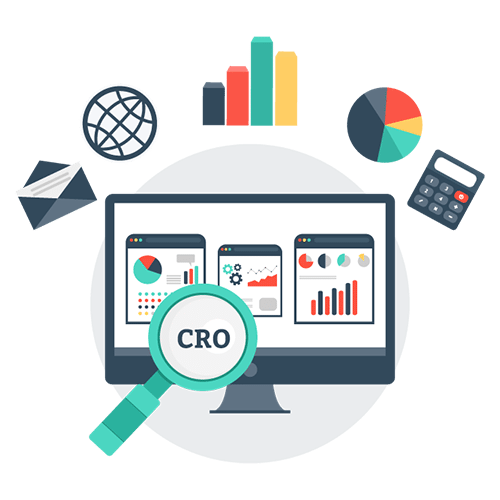Conversion rate optimization is optimum to use your existing resources and getting more conversion from your existing traffic.
This means it is the process of converting more percentage of visitors into payable customers by improving your products, based on user-generated data and your natural marketing sense.
TOPICS:
What is Conversion Rate?
Conversion rate is the percentage of the visitors who completed a desired action (subscribe for Netflix, buy a product from e-commerce site like amazon) set by the website owner.
It is easy to double your conversion rate than double your visitors. That is why more than 60 % of companies invest in optimizing the conversion rate of their website.
According to Venturebeat, the average ROI (return on investment) from a CRO tool is more than 220%. The goal of Conversion Rate Optimization is to increase the profit and revenue of the site.
Conversion rate can vary widely depending on your type of website (Blogging or e-commerce), Industry (auto, consumer service, education, real estate, etc.), Business model, etc. But no need to say, whichever industry you are working in, everybody wants a better Conversion rate.

How to calculate Conversion Rate?
The conversion rate is calculated by dividing the total conversion by the total number of visitors. Then multiply the number with 100 to get the percentage (%).
Why Conversion Rate Optimization is important
1) Rising pay per click cost:
Due to the rising popularity of the Google Adwords platform, the price of pay per click (PPC) also increases day by day.
That is why CRO is important to get the most out of the clicks you get.
2. Rising competition:
More and more content is published on the internet every day. That is why CRO is important to beat the competition.
3. Shorter attention Span:
Many studies show that today’s generation consumers have a shorter attention span than their parents. That is why CRO is important to grab the attention of the consumer fast.
4. Save your money:
CRO increases your conversion rate of your existing visitors. Thus, CRO leads to better revenue with the same traffic. That is why there is no additional cost to acquire new customers or to grow your business.

How to do Conversion Rate Optimization
1. Know first what to optimize, when to optimize, where to optimize, and for whom to optimize.
Do some survey and gather the date of underlying questions—-
(i) Which page of your website is most popular?
(ii)Who are your customers? (Nationality, religion, sex, age, interests, demographics, etc.)
(iii)Which is the most popular product?
(iv)Which is the most used feature?
(v)What device and browsers people use?
(vi)From where they came to your website?
After knowing this information, you can put your time, effort, and money into the pages, features, products, or services which were most popular?
2. Use Conversion Rate Optimization tools to gather more crucial information (quantitative data) about customers.
Below are some useful Conversion Rate Optimization tools you can check out.
3. Gather qualitative data using in-depth surveys, on-site surveys, chatbots, etc.
Quantitative Data
Qualitative Data
Numerical data like page visits, most visits, less popular, etc.
In-depth feedbacks, comments.
Objective approach
Subjective approach
Bounce rate
Cause for their abandonment
Pages least popular
Visitors doubts, hesitation, fears, etc.
Measurable data
Descriptive data
Conclusive approach
Exploratory approach
4. Identifying the areas of improvement: By collecting the date from the above steps, identify the areas which you can improve.

Conversion Rate Optimization strategies
1. The testing phase A/B testing, split testing, or multivariable testing:
(I) What is the significance of the test?
The primary reason for running a test is to understand if there is a better conversion for a change on our site.
(II) How long should I run a test?
Define a specific test duration to eliminate the problem of peeking (consider the test result before it is complete).
Test duration is determined by the number of visitors and your expected conversion rate.
(III) What test should I do- A/B, split, or Multivariable?
A/B testing is done to figure out which option works best between two alternatives. A/B testing is the most simple and thus the most popular. It is useful when the feature changes are not complex.
Split test useful when there is a major redesign of the whole website. It involves creating a new page sometime an entirely new URL.
Multivariate testing is used to test multiple variables. The goal of multivariable testing is to determine which set of combinations is most useful.
2. Use simple language:
No one wants to buy an ac with a smart inverter compressor, but everyone wants to buy an AC, which saves up to 45% of electricity.
3. Create a sense of urgency:
Create a sense of urgency by creating a sense of scarcity, FOMO(fear of missing out), social proof. To do that use terms like Limited time offer, only a few left, 200 people buy this product, etc.
4. Use videos, infographics, images to teach visitors about your product so that they purchase your product.
5. Reduce your bounce rate:
A high bounce rate indicates users do not want to pay you for the products or services. It indicates less engagement.
Tips & Trick to increase Conversion Rate
1. Make your website navigation smooth and simple.
2. Make a clear, eye catchy, and clickable CTA (call to action) buttons
3. Add contact information. Make your “about us” and contact us” pages super easy to find.
4. Make the purchasing process easy.
5. Make your website super fast. Decrease your website loading speed. Research shows that the websites take more than 2 sec to load have less net visitors than the sites which take less than 1 sec.
6. Make your website mobile-friendly. Nowadays more people use mobile phones to browse the internet.
7. Show why you are better than your competitor? Give them the reason to choose you over your competitor.
8. Use compelling heading: Use a heading that is related to the action you wanted to do by your visitors.
9. Use a concise, targeted copy. Make your copy content detailed but not lengthy. Use paragraphs, bullets, numbers to increase the readability of your content.
10. Attractive overall design: Make your website overall design great to offer a better user experience to your visitors.

Benefits of Conversion Rate Optimization
There are tons of benefits to CRO on your websites. They are as follows—-
1. Know your customers better:
The more CRO data you collect and implement, the more personalized and helpful products and services you can offer to your customers. More personalized services you offer, more they willing to pay you over your competitors.
2. Increase your bottom line:
More conversion means more sales and more profit. You can invest some of the money back to further increase your conversion rate.
3. Lower your COCA (Cost of customer acquisition): Acquire a new customer is always costlier than retaining the existing one. Thus, CRO helps to reduce your COCA.
4. Increase customer lifetime value:
Customer lifetime value is a very important factor. CRO helps to increase your CLV (customer lifetime value).
5. Take a calculated risk:
CRO lets you better understand your customers. As you have more data, you can take calculated risks to further improve your service.
6. Generate more lead:
The goal of CRO is to convert more percentage of your visitors into your customers.
5 Most common mistakes done by individuals while running a CRO campaign
1. Making changes based on opinions and gut feelings rather than user-generated data. Some people modify their sites by copying others.
2. Running a lot of tests at the same time. Doing multiple tests at the same time causes to create lots of confusion about the data generated from those tests. Too many tests at the same time also negatively affect the user experience.
3. Use the wrong color combinations in Call-to-Action buttons. Lots of study shows that different colors have a different effect on us. As a result, we react differently to different colors. Using the wrong colors in the call to action button can decrease the conversion rate.
4. Do not use power words in a call to action buttons. As the name suggests, power words cause a strong emotional reaction in human beings. If you do not use power words, you do not are not utilizing the impactful tool of CRO.
5. Not creating a sense of urgency.
Normal people tend to do procrastination. If you do not create a sense of urgency and do not give them a reason to buy your product right now, then your CRO will decrease.

Conversion Rate Optimization Tools
1. HubSpot
2. Unbounce
3. Lucky Orange
4. Google analytics
5. Google page speed
Conclusion
At last, it can be said that conversion is the ultimate goal of any business, and the optimization of conversion rate is an important step of marketing. Therefore you should apply CRO strategies to get more conversion out of your organic traffic.
CRO demands lots of effort because you have to run lots of tests to know what customers like most. Mainly the qualitative data are very useful. Make your website nice and clean, mobile-optimized, fast loading, and use a catchy call to action to convince more percentage of your audience to purchase your product. The ultimate goal of CRO is to increase your revenue.
FAQs
CRO and SEO are two different things. SEO is all about getting more organic traffic, and CRO is converting more percentage of visitors into payable customers.
Anyone who wants to increase his website leads and his profit.
When a company gets enough impressions but not enough clicks, then the company can use CRO to increase conversion rate.



